Group Exhibition by Alina and Jeff Bliumis, Irina Danilova, Yevgeniya Baras, Vydavy Sindikat
Curator: Yevgeniya Baras
Each artist in this exhibition is evoking a body or a stand in for the body, and the bodies on view are ethnic, distorted, chaotic, ambiguously gendered. But each artist examines the body through his or her own lens. At times, an overt dialogue of Otherness is made visible; in other cases, it is merely a whisper heard through the layers of multiple voices.
Jan 7 - Feb 19, 2012 at SET Gallery
When encountering the video work of Vydavy Sindikat, the audience is a voyeur to a dialogue. The video is of a private conversation where participants are ethnically ambiguous, the language is not English, the state is indistinctly tense. Introduced to this foreign situation, the viewer is simultaneously estranged from and placed into the role of the objectfier. One is invited to view in order to decide how to partake.
Looking at Yevgeniya Baras’s work, one comes in contact with the skin of paint, the crustiness, scarring, dryness, and layering of material, the many different modes that define the process of painting. Sometimes, she weaves the surface out of thin strips of canvas or sheets; occasionally, it’s papier-mache that composes the initial layer. She draws with yarn, sewing a pattern, gluing glass, foil, and paper onto canvas, or cuts and rips canvas before she begins the application of oil and acrylic paint. These works dance between sculpture and painting. They talk about an uneasy kind of beauty: unsettling and slightly repulsive. They are small and overloaded, sullied, dingy, burdened, compact, demanding bodies, loved and loathed in equal measure.
Irina Danilina’s work is created using hair. The cutting of hair is ceremonial, performative; it marks time, the stages of transformation. Hair is associated with crimes against humanity; it is what is left of the massacred. It is as much an element of beauty as it is what marks the body as ethnic. Hair both repulses and attracts, connoting desire and seediness. These braids on display are traces of a female mourning. These photographs provide context , documentation of performances passed, while the objects are contained in a scientific manner. They are trapped: the ethnic body made safe, nonthreatening, disarmed, limp.
Alina and Jeff Bliumis’s sculpture of bones overtly references the body. The bones are arranged in a circle, used as formal elements to create a composition. It is a mandala, a fragmented body reaching towards wholeness. The wooden sculptures are ambiguously gendered. They hint at masculinity and femininity but they can easily switch, can easily role-play. They make sense as a pair. As a couple, they are less vulnerable, their surface queer but armed, challenging heteronormativity. Unlike the seemingly fleeting material of Danilova’s work, these pieces are heavily present; they repeatedly reaffirm themselves. There is a density, a core of materiality in them. All three sculptures are firmly present, one in its fragmentation and two in their union. All three waver between body and spirit.





